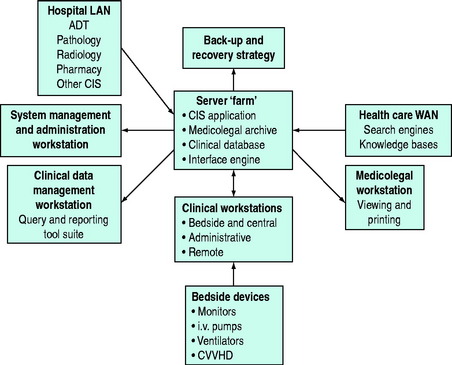Chapter 9 Clinical information systems
Clinical record-keeping requires an integrated system to manage the information, including its acquisition during clinical care, and archiving and availability for future clinical, business and research uses.
The term ‘clinical information systems’ (CIS) refers to computerised systems for managing the clinical record, often within specialised areas of a hospital, such as intensive care, emergency medicine, operating theatres or cardiology. CIS for intensive care units (ICUs) have been developing since the late 1980s; however, their implementation has been limited by cost, functionality and clinician acceptance.1–8
The electronic medical record (EMR) and electronic health care records (EHR) embrace respective hospital and community-wide electronic systems for managing patient records which may be integrated with the more specialised CIS. Over the next decade we can expect to see EHR implementation throughout the health systems of the more developed nations. The driving incentive is community concern for safety and quality in health care and the EHR is the single most powerful measure to produce a safer, more effective and efficient health care system.8–12
In the UK the National Health Service (NHS) has embarked on an ambitious National Programme for Information Technology (NPfIT) featuring a national summary care record (SCR) or ‘spine’ to hold limited essential information on each consenting patient. Additional features include picture archiving and communication systems (PACS), more detailed data held on integrated local computer systems, electronic prescribing and computerised physician order entry (CPOE).13,14
The US government has placed a high priority on electronic health records, although progress will be uneven due to the fragmented nature of its health system. The Veterans Health Administration (VHA) has a system-wide EHR (VistA) that is closely integrated with its quality monitoring and enhancement programme and is delivering tangible results.15–17 Similarly, the Partners HealthCare System at the Brigham and Women’s Hospital and Massachusetts General Hospital has demonstrated real improvements in health care with cost and quality benefit outcomes.18–21
The coordination of effort in Europe will be similarly challenging, although the need is recognised by the European Commission. In Australia, the HealthConnect strategy is largely focused on broadband connections for primary health care providers and establishing data dictionaries and standards with limited strategies or funding for actual implementation of EHRs.22
FUNCTIONS AND ADVANTAGES OF CIS
CIS seek to deliver several key benefits (Table 9.1).23 These include the automation of repetitive manual tasks, improved accuracy through reductions in human error, attributable records simultaneously available from multiple points of care and integration with other bedside equipment and information systems. The built-in error checking and knowledge-based systems should also provide a safer and higher-quality clinical process. The CIS electronically capture the data and make this information potentially available to a multitude of systems. This obviates the need for repetitive manual data entry or transcription, while making the data accessible for a range of purposes which may include clinical, business and research reporting.
Table 9.1 Clinical information systems (CIS) benefits
The patient record can then be accessed from geographically distant workstations in the ICU, the hospital, and even from other more remote sites. As long as the system is running, the record is easy to locate and always available.
A major contribution of CIS to clinical safety and quality is through the provision of an electronic prescribing and administration record for drugs and fluids. Errors in prescription and administration are a leading cause of adverse events with associated morbidity.18,24 CIS provide both legibility and varying levels of decision support which may include defining usual dosages and administration routes, suggesting dose modification in the setting of organ failures, or preventing prescribing in cases of known allergy or likely drug interaction.25
ARCHITECTURE AND COMPONENTS OF CIS
BASIC CIS ARCHITECTURE
All CIS share certain basic components consisting of workstations, a network and central servers (Figure 9.1). The user interface is presented at the workstation, which is usually at each bedside but may also be in nearby central and administrative areas, such as the nurses’ station, or more distant in the offices of clinical or administrative staff. Workstations commonly consist of relatively standard personal computer (PC) hardware being desk-, pendant or trolley-mounted, but may include laptops or personal digital assistants (PDAs) with wireless systems where technical challenges related to speed and reliabiltiy of data transmission can be overcome.
CIS usually require a separate workstation or server to manage the interfaces with other systems. These include hospital demographics (ADT systems for admission/discharge/transfer), pathology laboratory, pharmacy, radiology and hospital finance. Interfacing requires a software platform known as an interface engine. Additional software identifies the relevant data and directs and processes these data to the correct field in the appropriate format. Due to the huge variety of current and legacy systems, this process almost always requires custom-written code and programming, representing one of the major risks and expenses of systems integration.13
Bedside monitoring systems usually include a central station or server that can be linked with the CIS servers to transfer their downloaded information back to the bedside. Transferring data from other bedside devices is usually achieved by a cable connection from the device to a bedside concentrator in the patient bay. The connection requires an electronic decoder, specific to the manufacturer and model of the device. The concentrator must then communicate with the central servers via a subsidiary server that provides the software translator to complete the interface. A selection of established interfaces to commonly utilised equipment exists but often additional customised interfaces must be written.

Full access? Get Clinical Tree







